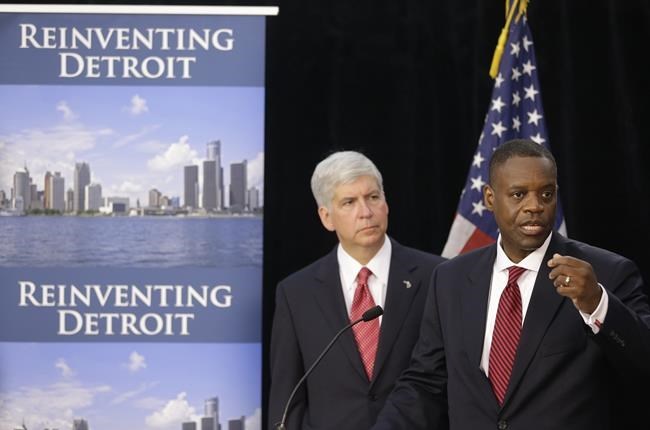
FILE - State-appointed emergency manager Kevyn Orr, right, and Michigan Gov. Rick Snyder address reporters during a news conference in Detroit, July 19, 2013, after Orr asked a federal judge for bankruptcy protection. Orr, the architect of Detroit's bankruptcy filing, admits it was a miserable process. But 10 years on he maintains the restructuring of the Motor City is among his most important accomplishments. (AP Photo/Carlos Osorio, File)
Republished July 18, 2023 - 8:09 AM
Original Publication Date July 17, 2023 - 9:16 PM
DETROIT (AP) — Detroit's newly hired emergency manager, Kevyn Orr, stood before reporters in March 2013 and issued a warning to city creditors, unions, vendors and others: “Don’t make me go to bankruptcy court. You won't enjoy it.”
On July 18, 2013, the restructuring expert did just that, making Detroit the largest city in the U.S. to file for bankruptcy.
What followed was months of negotiations, federal court hearings and an unlikely coming together of foundations to keep city-owned artwork from being sold to help pay off the debt.
“Bankruptcy is a miserable process," Orr, 65, told The Associated Press earlier this month, ahead of the 10th anniversary of the filing. "It puts everybody outside of their ordinary course, their common spaces.”
Detroit was determined by a state-appointed review team to be in severe financial distress in 2012. Soon after, then-Michigan Gov. Rick Snyder hired Orr — an attorney with the international law firm Jones Day — to take on the heavy lift of fixing a broken city.
Massive population loss that began in the 1950s and a decadeslong downturn in the auto industry and other manufacturers had severely slashed Detroit's tax base. Many neighborhoods were rife with vacant and burned out houses. Empty lots became dumping grounds for trash, used tires and even boats.
Poverty, unemployment and crime rates were among the highest in the nation.
The city’s budget deficit was north of $300 million. In the months before the bankruptcy, state-backed bond money helped the city meet payroll for its 10,000 employees. In the bankruptcy filing, Orr cited debt of $18 billion or more.
“This is a problem that’s been evolving for 50-plus years,” Snyder, a Republican, said during Orr's introduction. “This is a problem that now has reached a true crisis point.”
In 2013, underfunded obligations for pensions were about $3.5 billion. It was $5.7 billion for retiree health coverage.
Orr said the city once had 20,000 workers and 10,000 retirees who were owed pensions. By the time of the bankruptcy filing, those numbers were flipped with 20,000 retirees expecting pension payments.
“You can’t see those inverse yield curves and come away with a conclusion that this is going to end up well,” he said.
On top of that, the city had very few assets that could be sold to pay its debt. He listed city-owned paintings and sculptures at the Detroit Institute of Arts, parking lots and Detroit's water department. He warned then that the artwork could go on the auction block to help satisfy the city's staggering debt.
“It wasn’t a threat," he says now. “It was just: ‘Look, I’ve got a crisis. I need the money.’ We were getting overtures, both domestic and overseas, to buy some of the art."
Deep-pocketed foundations and the state stepped up and raised $800 million in what came to be known as the “Grand Bargain,” softening cuts to city pensions and placing the artwork in a charitable trust.
Without a consensual resolution with creditors, unions and others to solve the debt, “bankruptcy was the only vehicle that could achieve the outcome,” said Orr, who is now partner-in-charge for U.S. Offices at Jones Day.
Detroit exited bankruptcy in December 2014 with about $7 billion in debt restructured or wiped out. The city now boasts balanced budgets, improved services and a blight reduction effort that has led to the demolition of more than 24,000 vacant houses.
Prior to taking on Detroit’s troubles, Orr advised automaker Chrysler (now Stellantis) and National Century Financial Enterprises in their bankruptcies. He considers his experience in Detroit as among his top accomplishments.
“Probably, for me, (it was) the most personally satisfying because it was for people as opposed to corporations or businesses,” Orr said. "It ranks, certainly, among the highest of all the things I’ve fortunately been involved in.”
___
This story has been updated to correct Kevyn Orr’s current title to partner-in-charge U.S. Offices, not partner-in-charge of Jones Day’s office in Washington, D.C.
News from © The Associated Press, 2023